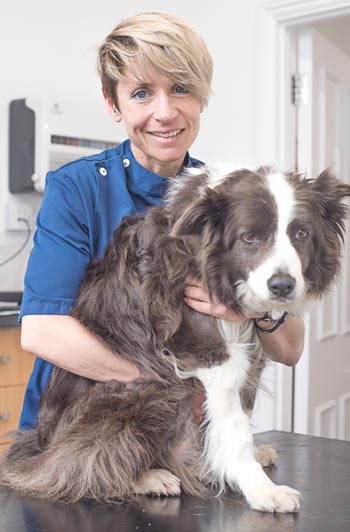1 Feb 2018
Bristol student Hannah Shotnes reports on a talk about the inadequate management of canine arthritis, and the need for a change in attitude and approach to this common condition.

Image © Canine Arthritis Management
The University of Bristol School of Veterinary Sciences recently hosted a talk by Hannah Capon – founder of Canine Arthritis Management (CAM)1 – which addressed the many issues surrounding the inadequate approach to canine arthritis in veterinary medicine.

Hannah is an extremely passionate and engaging speaker, who approached this disease from a place of empathy and compassion.
This was refreshing as a veterinary student who has – all too often – seen arthritic dogs dismissed as “just getting old”, the owner handed NSAIDs and left without an understanding of the disease or range of potential treatment options.
Signs of arthritis – such as lameness and exercise intolerance2 – are often seen as changes expected with age. Unfortunately, this is a common attitude of owners – and even some vets – towards this extremely painful condition.
Such one-dimensional management and poor attitude towards arthritis has resulted in many owners feeling an arthritic dog‘s course is predetermined – ultimately leading to an unacceptable impact on its quality of life.
Canine arthritis is one of the main causes of elective euthanasia in the UK1, and this concerning fact highlights the need for a change in the attitude and approach to this condition.
CAM aims to address this through increased awareness, education and long-term management plans1,3. Ultimately, it hopes to change the view of canine arthritis from being an expected part of ageing to a manageable condition that does not always result in euthanasia1,3.
Although canine arthritis continues to be highly relevant in veterinary medicine2, management of the disease is confronted by a plethora of problems. The most common form of arthritis in dogs is OA – the progressive, permanent degeneration of cartilage surrounding joints, resulting in chronic pain4.
Canine arthritis is still not very well understood, which is surprising, considering this condition is so common – four out of five dogs older than eight years old are affected – and familiar to many owners2,3. Both cats and dogs can be affected, but often, no further investigations are carried out following diagnosis.
In addition, one of the most critical issues addressed by Hannah was the deficit in effective communication with owners about the cause of arthritis, how drugs work and the range of treatment options available.
Arthritis is a complex condition that deserves more than the 15-minute consultation time vets are often limited to. Hannah outlined how many owners feel they are not given enough time or guidance, and insufficient understanding leads to poor compliance and reliance on other easily accessible sources, such as online advice and the recommendations of friends3.
One of the most thought-provoking points Hannah raised was the issue of chronic pain identification.

Many dogs appear stoic in the face of chronic pain, and this has led to many owners having numerous misconceptions about the level of pain their pets are enduring. These include beliefs dogs readily vocalise pain, would not continue to jump in the car or chase a ball if in pain, and would avoid the use of the affected limb(s)3.
One in five people claim to suffer from chronic pain3. We all know family members or friends who continue with their daily lives despite this, and the same is true for animals. This means owners commonly do not realise their dogs are suffering, so often do not visit their vet until the disease has progressed.
Identifying chronic pain is challenging due to the differences in the expression of pain between humans and animals, subjectivity in assessment and the difficulties in quantifying pain5.
Chronic pain assessment is essential to monitor progression of this disease, but many vets view the difficulties associated with this as significantly impeding effective arthritis treatment5, which often revolves around analgesia to manage symptoms2, 4. How can vets expect owners to identify signs of chronic joint pain in their animals if vets themselves find this difficult?
Many vets base the treatment regime for canine arthritis on disease severity, with pain often used to indicate this. Consequently, management may be ineffective in many cases if pain has not been accurately assessed6.
Hannah outlined some of the crucial changes that need to be implemented in the management of canine arthritis, and how improving communication with owners is key. Ensuring owner understanding of the disease process and how drugs such as NSAIDs work will help reassure fears about the long-term use of medications. This will, in turn, reduce use of alternative “remedies” pursued in the hope of safer treatment, but that tend to be ineffective and may not be designed for use in animals3,7.

Discussions with owners need prolonged time, and longer uninterrupted consults are essential to give this disease the attention it demands and deserves3,7.
The novel approach of CAM encourages tact and humanity at the forefront of interactions with owners, and Hannah is a firm believer vets should drop the white coat and remember empathy and positivity are vital. Vets need to be able to bridge the gap between professional and person, and place themselves in the position of owners3.
Hannah strongly encouraged vets and veterinary students to consider other factors apart from medical management, such as alterations to the animal‘s environment. Although advising owners about adaptions to the home in line with their dog’s needs can be difficult, this is an important element of arthritis management3.
Simple changes, such as tractable flooring or a ramp to avoid the step down into the garden, can make a remarkable difference to an animal’s quality of life3. Vets often focus on the medical aspect of the profession, but we also have a duty of care that goes beyond this.
Hannah also advocated additional tools for use in the management of canine arthritis. CAM has developed a 5 × 5 × 5 staging, grading and scoring protocol3. Staging and grading the disease allows appreciation of which point in the treatment plan and disease process the animal has reached, communication of prognostic indicators and a complete workup3.

Scoring the level of pain aids communication with owners, and can indicate when it is necessary to take further action to fully manage the condition3.
Further tools include tailored chronic pain charts, formalised reassessment plans and client-specific outcome measures (CSOMs)3.
CSOMs are semi-objective measures owners can use to monitor changes in impairment of behaviours regularly exhibited by cats and dogs, such as how easy their pets find different levels of exercise or use of the litter tray3,8.
Improving the tools available will enable owners to recognise the signs of chronic pain, as well as give them the tools to easily and effectively monitor their animal’s condition.
Canine arthritis is a common, well-known disease that needs a reform in the approach to the management of this condition, as encouraged by CAM1.

More research is needed to develop understanding of the disease – which will, in turn, improve treatment and prognosis.
Arthritis management should target a range of factors – not just medical options – and collaboration with colleagues and specialists in areas where vets do not have expertise will help with this, such as home modification and nutrition.
I highly recommend veterinary students and practising vets consider how arthritis cases are approached and take the issues raised by CAM on board – in particular, communication with owners, chronic pain identification and, most fundamentally, remembering age is not a disease.